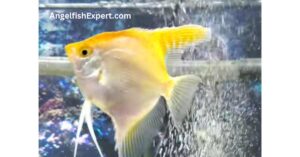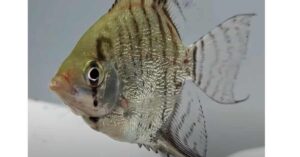Freshwater angelfish, scientifically known as Pterophyllum scalare, is one of the most popular aquarium fish species. They belong to the family Cichlidae and are native to South America. These beautiful creatures are loved by aquarists for their unique shape, stunning colors, and peaceful temperament. In this article, we will provide a complete guide for beginners on freshwater angelfish.
Tank Requirements for Freshwater Angelfish
Freshwater angelfish require a spacious tank with a minimum capacity of 20 gallons. The tank should be well-filtered, and the water temperature should be between 75°F and 82°F. The pH level of the water should be maintained between 6.0 and 7.5. It is recommended to keep them in groups of six or more, as they are social creatures and thrive in a group environment.
If you are interested, feel free to check an article I’ve written on how fast do Angelfish grow after doing a lot of research.
Types of Freshwater Angelfish
There are several types of freshwater angelfish, which are detailed as follows:
Altum Angelfish (Pterophyllum altum)

Pterophyllum altum, also called the altum angelfish, is a deep-water angelfish. It is also known as Orinoco Angelfish, as it strictly arises in the Orinoco River Basin. Continue reading about how to take care of Altum Angelfish
Albino Angelfish (Pterophyllum scalare var. albino)

Albino Angel is an angelfish that can be white or silver with a yellowish-orange ring coloration around its eyes and has red eyes. Albino angelfish is a rare and unique variant of the popular angelfish species. With their striking white coloration, these fish are highly sought after by aquarium enthusiasts.
Gold Angelfish (Pterophyllum scalare variety Gold)

Gold angelfish is also known as velvet dwarf angels. This fish is very popular because of its unique shape. Gold angelfish is a popular freshwater fish species known for their striking golden-yellow coloration and elegant appearance. These beautiful fish are a favorite among aquarium enthusiasts and can be found in many homes and public aquaria around the world. In this article, we’ll explore everything you need to know about gold angelfish, including their physical characteristics, habitat, feeding habits, breeding behavior, and more.
Zebra Angelfish (Pterophyllum scalare variety Zebra)

The fish has got the name for its zebra-like appearance with dark vertical stripes. They are diamond in shape. Zebra Angelfish, also known as Pterophyllum scalare, is a stunning freshwater fish species that are highly sought after by aquarium enthusiasts worldwide.
With its striking black and white stripes resembling the pattern of a zebra, this fish is not only visually appealing but also fascinating to observe. The Zebra Angelfish is a relatively hardy species that can adapt well to different water conditions, making it an ideal choice for both novice and experienced aquarists alike.
Leopard Angelfish (Pterophyllum scalare variety Leopard)

The fish got its name from its leopard-like appearance with spots. Leopard angelfish, also known as Pterophyllum Nourissati, is a unique species of freshwater fish that belongs to the cichlid family. Their striking appearance and behavior make them a popular choice for aquarium enthusiasts.
Koi Angelfish Care (Pterophyllum scalare var. Koi)

Are you on the hunt for a truly unique and eye-catching fish to add to your aquarium? Look no further than the koi angelfish! With their distinctive black and white patterning reminiscent of traditional Japanese koi fish, these beauties are sure to make a statement in any tank.
But koi angelfish aren’t just all looks – they also have fascinating behaviors and specific care requirements that make them a rewarding and engaging addition to your aquatic collection.
Black Lace Angelfish (Pterophyllum scalare variety black lace)

The Black Lace Angelfish is a highly popular fish that originated in South America. The fish is diamond-shaped. It is found in the Amazon River and many other areas, such as Colombia, Peru, etc. The Black Lace Angelfish is a popular freshwater fish known for its striking appearance and graceful swimming style.
These beautiful fish are native to the Amazon Basin in South America and are often found in slow-moving rivers and streams. What sets them apart from other angelfish species is their unique black lace pattern that appears like delicate threads woven intricately throughout their body. Their distinctive coloring makes them an eye-catching addition to any aquarium, and their docile temperament makes them a favorite among fish keepers of all skill levels.
Blushing Angelfish

Blushing Angelfish is a unique and sought-after color variation of the common Freshwater Angelfish (Pterophyllum Scalare) known for its striking appearance characterized by a pinkish-white blush on its cheeks and gills. In this article, we’ll cover everything you need to know about Blushing Angelfish, including their origins and breeding, habitat, tank requirements, and diet.
Marble Angelfish

These fish are a popular choice for both new and experienced fish keepers because of their beauty, peaceful temperament, and low-maintenance care requirements. continue reading about Marble Angelfish
Freshwater Angelfish Diet and Feeding

Freshwater angelfish are omnivorous and require a balanced diet. A high-quality flake food can form the base of their diet. Supplementing their diet with live or frozen foods such as brine shrimp, daphnia, or bloodworms is also recommended. Overfeeding should be avoided, as it can lead to digestive problems.
Breeding and Reproduction
Breeding freshwater angelfish can be a rewarding experience for aquarists. To breed them, a separate breeding tank should be set up with soft, acidic water. The water temperature should be maintained at around 80°F. The male and female will pair up, and the female will lay eggs on a flat surface. The eggs will hatch in two to three days, and the fry can be fed with freshly hatched brine shrimp.
If you are curious about is are angelfish saltwater fish then must read this detailed article. on this, we have covered everything about saltwater fish
Freshwater Angelfish for sale
Are you looking for a stunning addition to your aquarium? A freshwater angelfish might be just what you need! These graceful fish can grow up to 6 inches tall, and their unique triangular shape makes them stand out among other fish in your tank.
Freshwater angelfish are known for their striking colors and patterns, ranging from silver to black, and even marbled. They’re also relatively easy to care for, making them a great choice for beginners and experienced fish owners alike.
Like most fish, freshwater angelfish are social creatures and do best when kept in groups of six or more. They also prefer aquariums with live plants and plenty of hiding spots, like driftwood or caves.
If you’re interested in purchasing freshwater angelfish, make sure to buy from a reputable seller. Look for fish that are active, alert, and have bright colors. Also, make sure the tank they’re in is clean and well-maintained.
So, whether you’re a seasoned fish enthusiast or just looking to add some color to your tank, freshwater angelfish can make a beautiful and lively addition.
Angel fish colors
Here are some of the most common freshwater angelfish colors
- Silver
- Black
- Marbled
- Gold
- Albino
- Koi
Freshwater Angelfish tank mates: Good vs Bad
Good freshwater angelfish tank mates include larger fish that are also peaceful and have similar behavior to angelfish. Some examples of good tank mates include:
- Gouramis
- Corydoras Catfish
- Plecos
- Swordtails
- Mollies
- Livebearers
It’s important to note that even good tank mates can become territorial and aggressive towards angelfish if there aren’t enough space or hiding spots in the aquarium.
Bad freshwater angelfish tank mates include smaller or more aggressive fish that may nip at the fins of the angelfish. Some examples of bad tank mates include:
- Neon Tetras
- Bettas
- Tiger Barbs
- Guppies
- Angelfish (in smaller aquariums)
When choosing tank mates for freshwater angelfish, it’s important to research the behavior and size of each fish species beforehand to ensure they will get along well in the same tank.
My experience with Freshwater Angelfish
Freshwater angelfish have a diet that includes both protein-rich and vegetable-based foods. A balanced diet for angelfish should consist of high-quality flakes, pellets, and frozen or live foods like brine shrimp and bloodworms. It’s also a good idea to offer them boiled or blanched vegetables like spinach and zucchini. Overfeeding should be avoided, and angelfish should be fed in small amounts two to three times a day to prevent health issues and poor water quality in the aquarium.
Conclusion
So in this article, we have discussed the freshwater angelfish care guide highlights the essential factors for providing a suitable environment for these fish species.